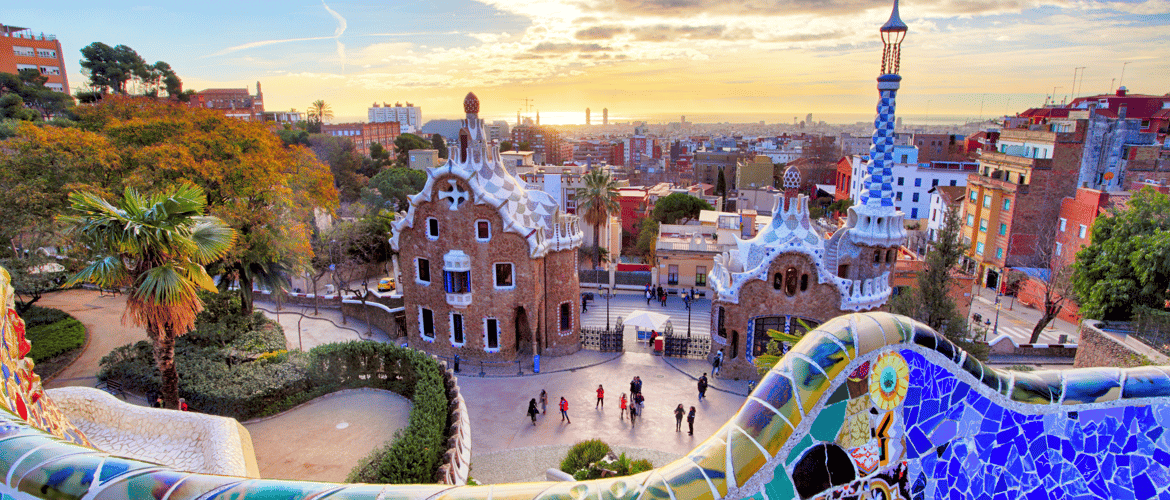Gaudi's Barcelona
Barcelona is a celebration of Antoni Gaudí's work. From the otherworldly landmark of La Sagrada Familia to the colourful mosaics of Park Güell, you will find a Gaudí icon in every corner of the Catalonian capital.
While the artist was born in Reus, south of the city, he spent much of his life in Barcelona. In 1870, he moved to the city to pursue his academic career in architecture, and while he was an inconsistent student, his incomparable talent opened many doors for them. When he completed his studies at the School of Architecture in 1878, the Director, Elies Rogent, declared: "I do not know if we have awarded this degree to a madman or to a genius; only time will tell."
Time did tell, and his unique style and charismatic creations have been long admired by architects around the world. His work was little influenced by his peers, but inspired by nature, reflected in the use of natural curved construction stones, twisted iron sculptures and organic-like shapes, with a colour palette representative of natural wonders. This distinctive combination is irreplicable, and his work offers viewers a breathtaking three-dimensional sight to this day.
There are so many fantastical Gaudí creations to see in Barcelona, here are just a few.
Torre
Bellesguard
Also known as Casa Figueres, this family home, also a castle, was
designed by Gaudí and constructured between 1900-1909. Perched high
on a hillside in the affluent Sarrià-Sant Gervasi district, the
Gothic-style building offers panoramic views over Barcelona. While
it is lesser visited than other landmarks, it gives insight into
his early work and artistic development - and is a peaceful spot
away from the hustle and bustle of the city below.
Palau
Güell
Gaudí designed this mansion for the industrial tycoon Eusebi Güell,
and it was built between 1886 - 1890. It is situated on the popular
street, Carrer Nou de la Rambla, and is rumoured to be the first
Art Nouveau building in the world. This moody building features
swaths of dark wood, marble floors and pillars, with a technicolour
roof terrace, topped by 20 chimneys and a 50-foot spire. Gaudí and
Güell collaborated again in the early 1900s, and created the city's
grand Park Güell; an almost make-believe landscape that features
the world-famous mosaic lizard and spiral towers that look like
fairground slides.
La Sagrada
Família
A church that needs little introduction, this extraordinary
building, which is also the world's largest unfinished church, is a
magical sight. The awe-inspiring Sagrada Família mesmerises
visitors with its soaring spires, intricate stone carvings, and
stunning stained glass windows. It would be almost sacrilege to
stay in Barcelona and not pay this momentous landmark a visit.
Casa
Batlló
Situated on Passeig de Gràcia, Casa Batlló's façade is covered in
shards of stained glass that shimmers in the sunlight. Commissioned
by textile revolutionary, Josep Batlló, who was impressed by
Gaudí's work at Park Güell, his brief was to create a completely
unique home, which also paid homage to Catalonia's patron saint,
Jordi, also known as Saint George of dragon-slaying fame. Like much
of Gaudí's work, Casa Batlló is influenced by nature, with no
straight lines, stone pillars that contort like animal bones, and
an ocean-blue stairwell. Inside, the LED-walled Gaudí Cube
immortalises his imagination, with a vivid, kaleidoscopic and
immersive display.
Within The Hideaways Club piso, Calle Princesa, there are a number of furnishings from the revered Casa Batlló Collection, including ornate door handles that are a near-perfect replica of the originals.
Casa
Vicens
The very first house Gaudí designed, Casa Vicens is an explosion of
colour, adorning a Moorish palace. Think ceramic flowers, flying
birds, oriental palms and pink walls, topped by domes and a
terracotta roof terrace. It was built in the 1800s as a summerhouse
for stockbroker Manel Vicens, and following a refurb in 2017, it
opened as a museum space for visitors.
While Barcelona is a charming city to explore with or without artistic appreciation, Gaudí left an indelible mark here that is tangible. You'll find it hard not to lose yourself in the otherworldly magic.
Related Articles

The Journal - Spring 2025
11th April, 2025
Spring into summer with the latest edition of The Journal. Read more

48 hours in Barcelona
12th February, 2024
Barcelona, the capital of Catalonia, Spain, is a magical Mediterranean metropolis. At once ... Read more

A taste of tapas in Barcelona
25th March, 2019
"You'd have a hard time finding anything better than Barcelona for food, as ... Read more

